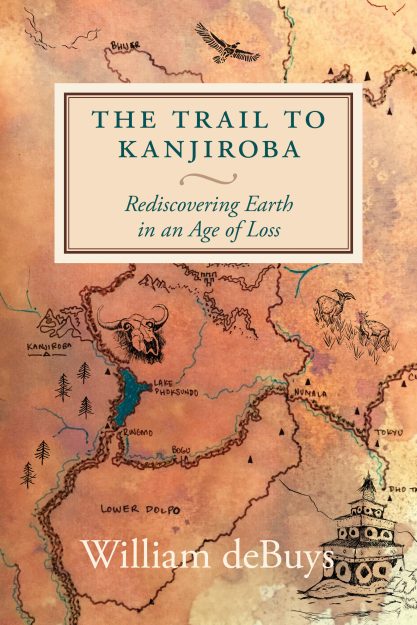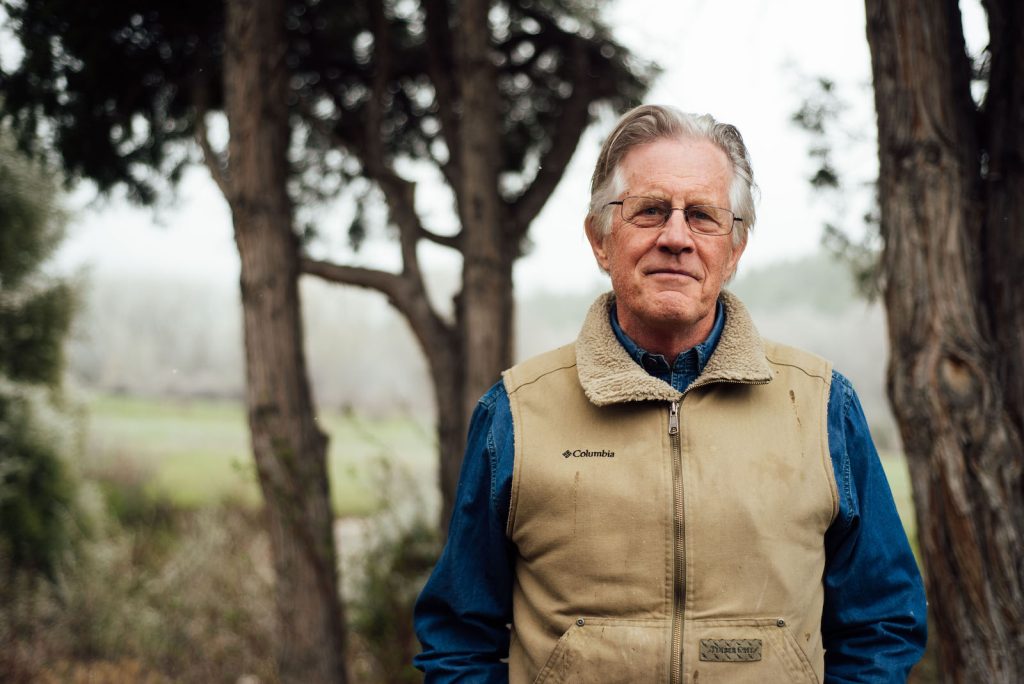Join William DeBuys and Zen priest Kritee Kanko for “Finding Grace Amidst Climate Grief,” a virtual event on April 20. As part of Tricycle’s weeklong event series, The Buddhism and Ecology Summit, we’ll be featuring a series of conversations with Buddhist teachers, writers, environmental activists and psychologists on transforming eco-anxiety into awakened action. Learn more and sign up here.
In 2016 and 2018, conservationist William deBuys joined Roshi Joan Halifax and a team of medical clinicians as they trekked through the Himalayas providing basic medical support to the residents of the region. A lifelong environmental activist, deBuys set out on the expedition with an unusual question: How can we apply the ethics of hospice to the environmental movement? Over the course of six weeks, he accompanied doctors and nurses through northwestern Nepal as they cared for patients whose illnesses were incurable, doing what they could to provide relief from immediate suffering.
In his latest book, The Trail to Kanjiroba: Rediscovering Earth in an Age of Loss, deBuys reflects on how the expeditions transformed his understanding of hope, grief, and loss, as well as what it means to care for the planet. Tricycle sat down with deBuys to discuss his time in the Himalayas, the role of awe in the environmental movement, and how we can harness and honor our rage.
Can you share more about your expeditions through the Himalayas in 2016 and 2018? I had to go on the second expedition to make sense of the first—the first was just so full of new experiences that I couldn’t process it all, let alone squeeze the real learning from it. In the first expedition, we [the members of the Nomads Clinic] were on the trail for about six weeks. We traveled about 150 miles on foot and on horseback through the Himalayas. We held six major clinics, and the doctors and nurses also provided a lot of medical care incidentally as we went along. We treated about 900 patients, and we provided acupuncture and foot massages to hundreds more.
Along the way, the trip was also a pilgrimage. We visited many gompas, or monasteries, and holy places. We participated in a number of rituals, and we interacted with lamas and village leaders. Often, as a way of thanking the clinic for the ibuprofen and the antibiotics and the foot massages, a village would collectively put on a cultural performance, which consisted of singing and dancing, often under the starlight on a cold, cloudless night at 13,000 feet above sea level. It was a spectacular experience.
You originally set out on the trip with the intention of applying hospice ethics to how we care for the earth. How did you come to this notion of hospice for the earth? For most of my adult life, I’ve worked in land conservation and environmental work. In recent decades, I’ve lost some friends and supported them on their way out of this world, and so it became natural to blend the various things I was thinking about into a consistent set of themes. Hospice for the earth arose from my hunger for a way of thinking about how we can continue our efforts to make the planet healthier and curb our own negative influences on it. In hospice care, you accept the trends of where things are going, and instead of focusing on the big fix, you focus on making things as good as you can, right here and now, for as long as you can. It requires you to relinquish attachment to outcomes and to focus on the fullness of the present. I find a lot of relief in that shift.
One of the phrases that you repeat throughout the book is “care over cure.” Can you share more about how this philosophy played out on the medical expeditions to the Dolpo region of Nepal? I learned the phrase “care over cure” from Roshi Joan Halifax, who led the expeditions into Dolpo. That was her injunction to the doctors and nurses and health practitioners who were part of our clinic: not trying for a “big fix,” which was, in most instances, impossible anyway because we didn’t have blood labs and X-rays and surgical operating rooms. We were working with limited tools to try to help people get through the days and the weeks and the months ahead more happily than they would have otherwise. That was one of the unifying ethics of our entire effort in Dolpo: there was no big fix, so we had to focus on the care we could provide.
This lack of a “big fix” is a major theme in the climate movement as well. How can we work with this sense of futility or impossibility without turning to despair? I’d like to change the word from futility to impermanence. I believe that as long as it’s done with care, nothing is futile. And so you do the best you can and relieve the suffering that you can, and you know that nothing is going to last forever. Part of my meditation going through the Himalayas was to look at how young the landscape was and to know that those mountains had risen from sea floors over millions of years. To be aware of that on a daily basis really shook my worldview. Applying that understanding of change to human affairs can be liberating. Nothing is going to remain the same. But it does not follow, logically or emotionally, that because nothing lasts forever, we should stop doing what we can in the present moment to make this moment richer and happier and less painful.
Throughout the book, you write about the deep sense of wonder that being in the Himalayas inspired in you. Can you speak to the role of awe in the climate justice movement? In particular, how can awe support us in protecting the environment? One of my goals in writing the book was to make it a celebration of the beauty of Earth. Celebrating the beauty of Earth is also a celebration of the awe we experience when we behold it. The book tells the stories of Charles Darwin and of various Earth scientists who came up with the theory of plate tectonics. For me, these scientific narratives are stories about the pursuit and acquisition of full-time awe, of delight and admiration and wonder at the marvelousness of life on this planet.
As we struggle to protect life on this planet from climate change and the erosion of biodiversity, I think we need to renew our awareness of the beauty of Earth. Our species has only been around for about 300,000 years. We’re newcomers. There are so many mammal species that have been around for a couple of million years, and the reptiles and birds have been here even longer. When we think about the beauty that we have inherited, we have a moral obligation to preserve that beauty. We will fail to some degree. But we can also succeed to a considerable degree. We know that more species will be coming along. We know that our own species will eventually die out, as all species will over time. But for now, we’re part of a big experiment in the vastness of the universe, and given our gift of consciousness and awareness, we need to live up to our role and the benefits we have received from this creation of which we are a part.
When thinking about the destruction of the climate, it can be so easy to get angry. In the book, you write about sacred rage and how we can harness our anger productively. What do you mean by sacred rage, and how can we work with our anger to enact meaningful change? I think that a person would have to be fully anesthetized not to feel angry about the chain of events that has taken us to such a critical point in the climate crisis: the buying of politicians, the spread of disinformation, and the role of Big Oil and Big Coal in diverting society from doing what has clearly been needed for a long time. But just being angry isn’t good enough. We need to channel that anger and focus it. I borrowed the concept of sacred rage from my friend Terry Tempest Williams, the environmental activist and author. Sacred rage is a rage that is focused. It’s not just letting off steam. It’s using steam the way a steam turbine uses it, focusing its heat and velocity to do work in a physical sense: to achieve something and get things moving. That’s how we need to use our rage: not just to blow off the steam but to focus it so that we accomplish something with it. That, to me, is living up to the sacredness of that kind of rage.
You also write about how the physical act of walking can teach us how to process and hold our grief. What have you learned from the act of walking? One day as I was walking, a realization came into my mind: The right way to carry the grief is the right way of walking. It was like a metronomic reminder or a mantra. The rhythm of this mantra matched my steps, so I marched to its beat. Then I reversed the phrases: The right way of walking is the right way to carry the grief. That idea unlocked the deepest discovery in the expedition for me. We had walked together for six weeks. We had formed a community through walking, and the trail became home. We were on a big circular journey, which in Tibetan Buddhism is called a kora. In a kora, you return to the point where you began, but with every revolution, you learn how to walk just a little bit better. Since the trip, almost every day, I realize that here I am, I’m 72 years old, and I am still learning how to walk. I apply that idea all the time: Just try to walk a little bit better.
Do you have any recommendations for practices we can engage in to facilitate awe and connection with the earth? Once in a while, we have the gift of encountering an animal in a non-hostile way, and that can give that sense of connection. But I think just being in place and being genuinely alert and aware, being still and quiet enough to allow a wild place reveal itself to you: that, to me, is a skill that is really healthy to cultivate. It’s not fundamentally different from preparing yourself to allow beauty to come into yourself on a regular basis.
I was originally attracted to the stories of Darwin and plate tectonics because they’re really stories driven by awe, by this desire to make sense of this spectacular world in which we live—and to do so without resorting to magic. To me, that’s part of the spectacular moment in history that we now inhabit: we can tell ourselves the biography of Earth without relying on magic. We’re the first people who have been able to do that. This is the great irony and paradox of our time: we have this knowledge, which opens the gates of wonder and spreads them wider than they’ve ever been spread before, and at the same time, we’re doing so much to destroy this marvelous creation of which we are a part. In a way, The Trail to Kanjiroba is my attempt to reconcile those two irreconcilable facts. It’s an attempt to find grace amid the grief.

[This article was first published on July 31, 2022]
Thank you for subscribing to Tricycle! As a nonprofit, we depend on readers like you to keep Buddhist teachings and practices widely available.
